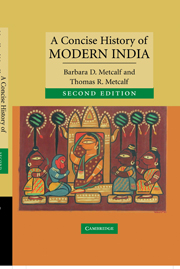Book contents
- Frontmatter
- Contents
- List of illustrations
- Preface to the second edition
- Preface to the first edition
- Glossary
- Chronology
- 1 Sultans, Mughals, and pre-colonial Indian society
- 2 Mughal twilight: the emergence of regional states and the East India Company
- 3 The East India Company Raj, 1772–1850
- 4 Revolt, the modern state, and colonized subjects, 1848–1885
- 5 Civil society, colonial constraints, 1885–1919
- 6 The crisis of the colonial order, 1919–1939
- 7 The 1940s: triumph and tragedy
- 8 Congress Raj: democracy and development, 1950–1989
- 9 Democratic India in the nineties: coalitions, class, community, consumers, and conflict
- Epilogue: a new century begins
- Biographical notes
- Bibliographic essay
- Index
- CAMBRIDGE CONCISE HISTORIES
2 - Mughal twilight: the emergence of regional states and the East India Company
Published online by Cambridge University Press: 05 June 2012
- Frontmatter
- Contents
- List of illustrations
- Preface to the second edition
- Preface to the first edition
- Glossary
- Chronology
- 1 Sultans, Mughals, and pre-colonial Indian society
- 2 Mughal twilight: the emergence of regional states and the East India Company
- 3 The East India Company Raj, 1772–1850
- 4 Revolt, the modern state, and colonized subjects, 1848–1885
- 5 Civil society, colonial constraints, 1885–1919
- 6 The crisis of the colonial order, 1919–1939
- 7 The 1940s: triumph and tragedy
- 8 Congress Raj: democracy and development, 1950–1989
- 9 Democratic India in the nineties: coalitions, class, community, consumers, and conflict
- Epilogue: a new century begins
- Biographical notes
- Bibliographic essay
- Index
- CAMBRIDGE CONCISE HISTORIES
Summary
Our time traveller in 1707, especially if he had been misled by European accounts of ‘Oriental despots’, may well have failed to appreciate the extent to which the Mughal Empire, like other pre-modern political systems of that scale, operated by a hierarchic distribution of authority among different levels of society. There was no monopoly of military force; there was no monopoly of political authority. The Mughal himself was shahinshah, ‘king of kings’, hence one sovereign among many. Competition to expand geographically was always endemic, as was competition between the vertical levels of the system. It is conflict, as Bernard Cohn has written using the late Mughal period as an example of such systems, that achieves the precarious consensus and balance that allows such political systems to persist. Effective rule required not only resolving competition but also judgment about the conflicts with which to engage. During the first half of the eighteenth century Mughal power contracted, while those who had once been subordinate to the Mughals flourished. Among the new regional powers was a joint stock company of English traders, which, by century's end, was poised to claim the mantle of the Mughals as ruler of the subcontinent.
THE ‘FAULT LINES’ OF MUGHAL CONTROL
A cogent perspective on Aurangzeb as ruler comes from one Bhimsen, a Hindu Kayastha memoirist, who, in his final decades of service, acted as auditor and inspector for a Rajput noble.
- Type
- Chapter
- Information
- A Concise History of Modern India , pp. 29 - 55Publisher: Cambridge University PressPrint publication year: 2006

